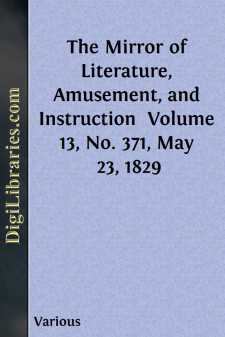Categories
- Antiques & Collectibles 13
- Architecture 36
- Art 48
- Bibles 22
- Biography & Autobiography 813
- Body, Mind & Spirit 142
- Business & Economics 28
- Children's Books 17
- Children's Fiction 14
- Computers 4
- Cooking 94
- Crafts & Hobbies 4
- Drama 346
- Education 46
- Family & Relationships 57
- Fiction 11829
- Games 19
- Gardening 17
- Health & Fitness 34
- History 1377
- House & Home 1
- Humor 147
- Juvenile Fiction 1873
- Juvenile Nonfiction 202
- Language Arts & Disciplines 88
- Law 16
- Literary Collections 686
- Literary Criticism 179
- Mathematics 13
- Medical 41
- Music 40
- Nature 179
- Non-Classifiable 1768
- Performing Arts 7
- Periodicals 1453
- Philosophy 64
- Photography 2
- Poetry 896
- Political Science 203
- Psychology 42
- Reference 154
- Religion 513
- Science 126
- Self-Help 84
- Social Science 81
- Sports & Recreation 34
- Study Aids 3
- Technology & Engineering 59
- Transportation 23
- Travel 463
- True Crime 29
The Mirror of Literature, Amusement, and Instruction Volume 13, No. 371, May 23, 1829
by: Various
Categories:
Description:
Excerpt
The Fortune Playhouse
The Engraving represents one of the playhouses of Shakspeare's time, as the premises appeared a few years since. This theatre was in Golden Lane, Barbican, and was built by that celebrated and benevolent actor Edward Alleyn, the pious founder of Dulwich College, in 1599. It was burnt in 1624, but rebuilt in 1629. A story is told of a large treasure being found in digging for the foundation, and it is probable that the whole sum fell to Alleyn. Upon equal probability, is the derivation of the name "The Fortune." The theatre was a spacious brick building, and exhibited the royal arms in plaster on its front. These are retained in the Engraving; where the disposal of the lower part on the building into shops, &c. is a sorry picture of the "base purposes" to which a temple of the Drama has been converted.
According to the testimony of Ben Jonson and others, Alleyn was the first actor of his time, and of course played leading characters in the plays of Shakspeare and Jonson. He was probably the Kemble of his day, for his biographers tell us such was his celebrity, that he drew crowds of spectators after him wherever he performed; so that possessing some private patrimony, with a careful and provident disposition, he soon became master of an establishment of his own—and this was the Fortune. Although Alleyn left behind him a large sum, it is hardly probable that he made it here; for in his diary, which, we believe is extant, he records that he once had so slender an audience, that the whole receipts of the house amounted to no more than three pounds and a few odd shillings—a sum which would not pay the expenses; for it appears by the MS. of Lord Stanhope, treasurer to James I. that the customary sum paid for the performance of a play at court, was 20 nobles, or 6l. 12s. 4d. Alleyn was likewise proprietor of the Blackfriars' Theatre, near what is still called Playhouse Yard. However he might have gathered laurels on the stage, he must have gained his fortune by other means. He was keeper of the King's Bear Garden and Menagerie, which were frequented by thousands, and produced Alleyn, the then great sum of 500l. per annum. He was also thrice married, and received portions with his two first wives; and we need not insist upon the turn which matrimony gives to a man's fortune.
Among the theatrico-antiquarian gossip of The Fortune is, that it was once the nursery for Henry VIII.'s children—but "no scandal about the"—we hope.
EXHIBITION OF THE ROYAL ACADEMY.
All men are critics, in a greater or less degree. They can generalize upon the merits and defects of a picture, although they cannot point out the details of the defects, or in what the beauty of a picture consists; and to prove this, only let the reader visit the Exhibition at Somerset House, and watch the little critical coteries that collect round the most attractive paintings. Could all these criticisms be embodied, but in "terms of art," what a fine lecture would they make for the Royal Academy....












